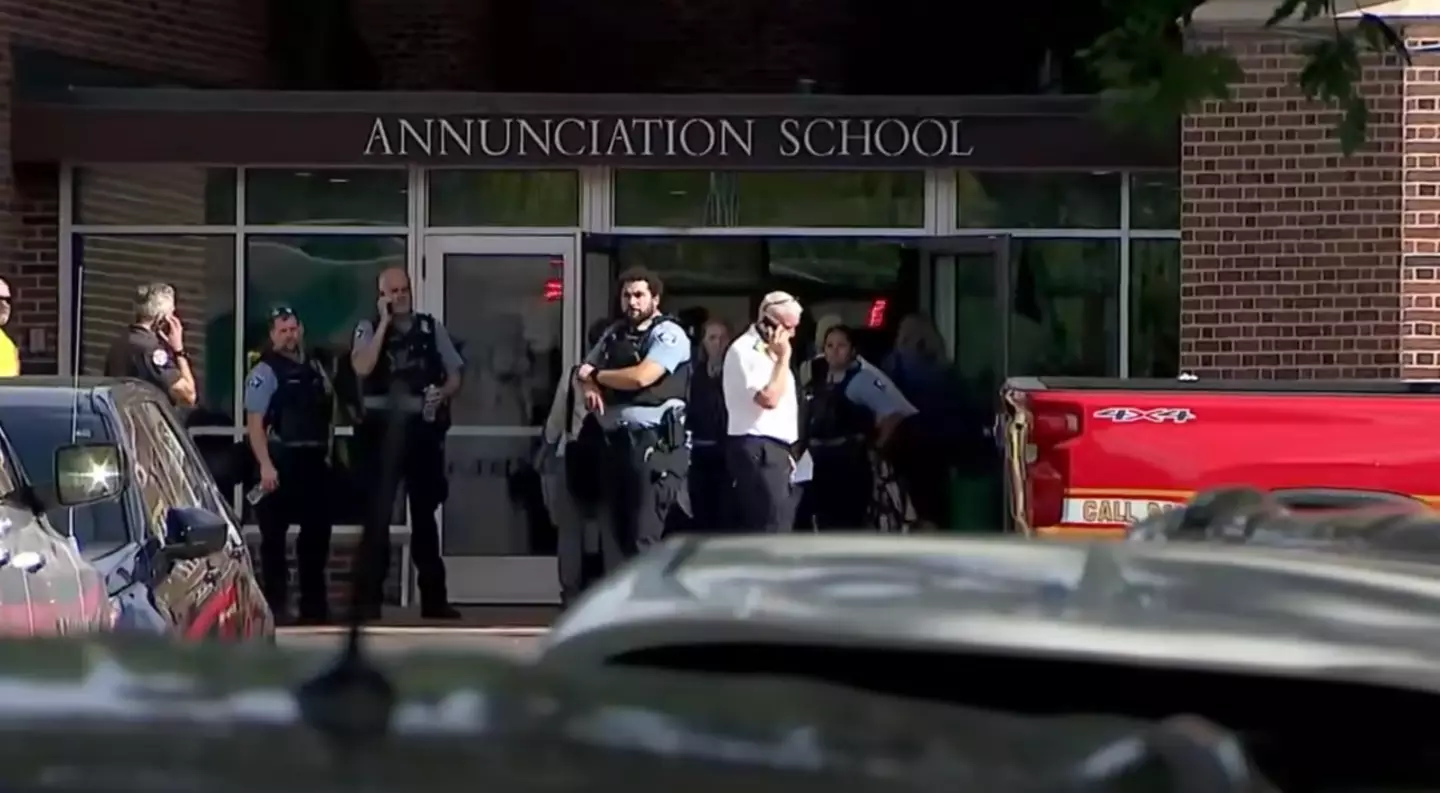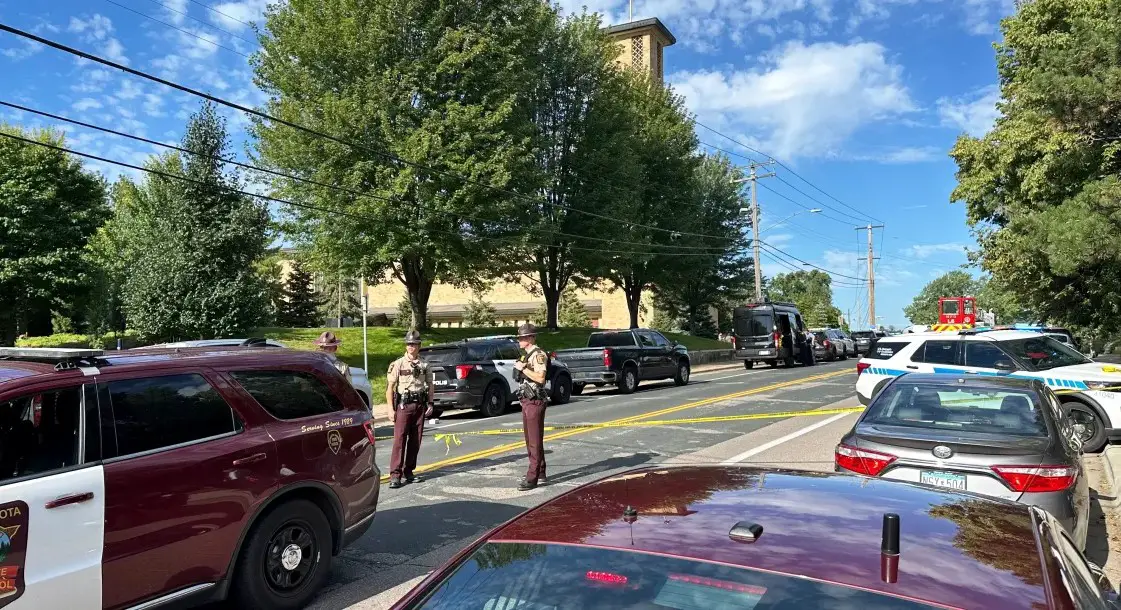A devastating act of violence has shattered the back-to-school atmosphere at a Minneapolis elementary school, sending shockwaves through a community and prompting urgent responses from the highest levels of government. The incident, which unfolded during what should have been a routine Tuesday morning at a Catholic school, has once again thrust America’s ongoing struggle with gun violence into the national spotlight while raising profound questions about school security and the safety of children in educational settings.
The Scene Unfolds: Emergency Response in South Minneapolis
The shooting erupted at Annunciation Catholic School in south Minneapolis, transforming a quiet residential neighborhood on West 54th Street into a scene of chaos and emergency response. The area between Lyndale and Nicollet Avenue quickly became cordoned off by law enforcement and emergency responders as reports of injuries began to emerge from the elementary school campus.
According to two federal law enforcement sources who spoke with CBS News, as many as 20 people may have sustained injuries during the incident, though the full extent and severity of those injuries remained unclear in the immediate aftermath. The sources described the shooter as a man dressed entirely in black who was observed carrying a rifle, details that painted a chilling picture of the violence that had invaded this educational sanctuary.

The shooting took place on students’ first week back in school (LiveNOW from FOX)
The timing of the attack proved particularly devastating, occurring during the students’ first week back at school following summer vacation. Children who had likely spent the morning excited about reuniting with friends and beginning a new academic year instead found themselves thrust into a nightmare scenario that no child should ever experience.
Local authorities moved quickly to contain the situation, with Minneapolis police confirming to BBC News that there was no longer an active gunman in the area. The official City of Minneapolis account provided crucial reassurance to the broader community, stating there was an “active police situation” but emphasizing there was “no active threat to the community at this time.”
“The gunman is contained,” city officials announced, though they noted that the school remained an active crime scene as investigators began the painstaking work of documenting evidence and piecing together the sequence of events that led to this tragic incident.
Presidential Response: Trump Issues Statement from White House
President Donald Trump responded swiftly to news of the shooting, taking to his Truth Social platform to address the nation about the unfolding tragedy. His statement reflected the gravity of the situation while attempting to provide reassurance about the federal response to the crisis.
“I have been fully briefed on the shooting,” Trump wrote, emphasizing the administration’s immediate engagement with the situation. “The FBI quickly responded and they are on the scene.” This rapid federal involvement underscored the seriousness with which the administration was treating the incident and the priority placed on school safety.
The President’s message continued with a commitment to ongoing monitoring of the situation: “The White House will continue to monitor this terrible situation.” This pledge of sustained attention from the highest levels of government reflected both the immediate crisis response and the longer-term implications of yet another school shooting in America.
Trump concluded his statement with a call for national unity in the face of tragedy: “Please join me in praying for everyone involved.” This appeal to prayer and collective support has become a familiar refrain in presidential responses to mass violence, reflecting both the personal toll of such incidents and the search for meaning in the aftermath of senseless violence.
The presidential response came as part of a broader pattern of high-level government engagement with school shootings that has evolved over decades of such incidents. The immediate involvement of federal agencies and presidential statements has become standard protocol, reflecting both the national scope of concern about school safety and the political imperatives surrounding gun violence.
State Leadership Mobilizes: Governor Walz Coordinates Response
Minnesota Governor Tim Walz, who has navigated previous crises during his tenure, quickly mobilized state resources in response to the shooting. His administration coordinated with state patrol authorities to ensure adequate law enforcement presence at the scene while supporting local emergency response efforts.
“I’m praying for our kids and teachers whose first week of school was marred by this horrific act of violence,” Walz wrote in a post on X, formerly Twitter. His words captured the profound sense of loss and violation that school shootings inflict on entire communities, particularly when they occur at the beginning of what should be a hopeful and promising academic year.
The Governor’s response reflected the complex emotional and practical challenges that state leaders face when confronting school violence. Beyond the immediate crisis management requirements, such incidents force governors to grapple with broader questions about school security funding, mental health resources, and the effectiveness of existing safety protocols.
Walz’s coordination with state patrol authorities demonstrated the multi-layered law enforcement response that has become standard in school shooting incidents. The integration of local, state, and federal resources reflects lessons learned from previous tragedies about the need for comprehensive and coordinated emergency response capabilities.
Congressional Response: Senators Address National Implications
The shooting prompted immediate responses from Minnesota’s congressional delegation, with Senator Tina Smith issuing a statement that captured both gratitude for the emergency response and frustration about the persistent threat of school violence. Her comments reflected the complex emotions that elected officials experience when tragedy strikes their home states.
“I’m grateful for the quick response of law enforcement as we continue to gather information,” Smith wrote on X, acknowledging the professional competence of emergency responders while recognizing that the full scope of the incident remained unclear. “It’s the first week of school. These kids should not be fearing for their lives.”
This final observation struck at the heart of one of America’s most troubling realities: the extent to which school violence has become a normalized part of the educational experience for millions of children. Smith’s words reflected a broader societal recognition that the fear of school shootings has fundamentally altered childhood and education in ways that previous generations could never have imagined.
The senator’s statement also highlighted the timing element that made this particular incident especially painful for the community. The first week of school traditionally represents new beginnings, fresh starts, and optimistic expectations about the year ahead. The intrusion of violence into this hopeful moment added layers of psychological trauma that extended far beyond the immediate physical injuries.
Federal Security Response: Homeland Security Engagement
US Secretary of Homeland Security Kristi Noem characterized the shooting as “horrific” and confirmed that the Department of Homeland Security was actively monitoring the developing situation. This federal involvement reflected the national security implications that school shootings have acquired in the post-9/11 era.
The DHS monitoring represents part of a broader federal infrastructure that has evolved to address domestic security threats, including the specific challenge of school violence. This institutional response reflects both the scale of resources that the federal government can bring to bear in crisis situations and the recognition that local communities often require external support when confronting such traumatic incidents.
Noem’s characterization of the shooting as “horrific” also reflected the personal and emotional dimensions of leadership during crisis situations. While government officials must maintain professional composure and coordinate practical responses, they also serve as voices for collective grief and outrage when communities suffer violence.
The Department of Homeland Security’s involvement in school shooting responses has evolved significantly since its creation, reflecting the agency’s expanded understanding of domestic security challenges. While initially focused primarily on international terrorism threats, DHS has increasingly recognized the domestic security implications of mass violence incidents, particularly those targeting educational institutions.
Community Response: Reunification and Recovery Efforts
Local authorities quickly established emergency protocols designed to manage the immediate aftermath of the shooting while supporting affected families. A family reunification zone was set up at 525 West 54th Street, providing a designated location where parents and guardians could reconnect with their children in a controlled and secure environment.
The Minneapolis Police Department issued public guidance that reflected both the immediate security concerns and the practical challenges of managing a complex emergency scene. “The public is advised to stay away from the area to allow emergency personnel to help victims – W. 54th Street between Lyndale and Nicollet Ave,” the department stated, emphasizing the need to maintain clear access for emergency responders.
The establishment of a reunification zone has become standard protocol in school shooting responses, reflecting lessons learned from previous incidents about the importance of providing structured environments for family reunification. These designated areas serve multiple purposes: they ensure that children are safely returned to their families, they provide locations for trauma counseling and support services, and they help law enforcement maintain control over the crime scene while accommodating the urgent needs of affected families.
The choice of the Annunciation School building itself as the reunification site reflected practical considerations about space and familiarity, while also symbolically representing the community’s determination to reclaim their educational space from violence. This decision demonstrated the delicate balance between security concerns and the psychological needs of families seeking to reunite with their children.
The Broader Context: America’s Ongoing Struggle with School Violence
The Minneapolis shooting occurred against the backdrop of America’s persistent struggle with school violence, a challenge that has fundamentally altered the educational experience for millions of students, teachers, and families. The incident at Annunciation Catholic School represents another entry in a tragic catalog of school shootings that have occurred with disturbing frequency across the United States.
The targeting of an elementary school added particular poignancy to this incident, as younger children represent society’s most vulnerable population and are least equipped to understand or cope with exposure to violence. Elementary schools have historically been viewed as especially safe spaces, making incidents like this one particularly shocking to community sensibilities and parental expectations about school security.
The religious nature of the targeted school also added dimensions of meaning and motivation that investigators would need to explore. Catholic schools, like other religious educational institutions, occupy a unique place in American society, serving diverse communities while maintaining distinctive faith-based educational missions. Understanding whether the religious character of the school played any role in the incident would likely become a focus of the ongoing investigation.
The first-week-of-school timing amplified the emotional impact of the shooting, as it occurred during a period traditionally associated with hope, new beginnings, and positive expectations about the academic year ahead. This timing disrupted not only the immediate educational environment but also the broader community’s sense of optimism about the school year and children’s educational experiences.
Security Protocols and Emergency Preparedness
The response to the Minneapolis shooting demonstrated the evolution of school security protocols and emergency preparedness systems that have developed in response to decades of school violence incidents. The rapid coordination between local, state, and federal law enforcement agencies reflected institutional learning about the importance of comprehensive and immediate response capabilities.
The speed with which authorities were able to confirm that the gunman was “contained” and that there was no ongoing threat to the broader community reflected improved communication systems and crisis management protocols. These capabilities represent significant investments in training, technology, and coordination that school districts and law enforcement agencies have made in response to previous tragedies.
However, the incident also raised ongoing questions about the balance between security measures and the maintenance of welcoming, educational environments that support children’s learning and development. Schools face the challenge of implementing effective security protocols without creating fortress-like environments that themselves traumatize students and undermine educational missions.
The involvement of multiple law enforcement agencies, including the FBI, reflected both the seriousness with which authorities treat school violence and the resources available for investigation and response. This multi-agency approach has become standard in school shooting cases, reflecting recognition that such incidents often have implications that extend beyond local jurisdictions.
Investigation and Motive: Seeking Understanding in Tragedy
At the time of initial reporting, investigators had not yet determined a motive for the shooting, leaving the community and the broader public to grapple with the fundamental question that haunts all such incidents: why? The absence of immediate explanation for the violence added to the sense of randomness and vulnerability that school shootings create in communities.
The investigation into motive would likely explore multiple potential factors, including the shooter’s personal history, any connections to the school or its community, mental health considerations, and possible ideological motivations. The thoroughness of this investigation would be crucial for both legal proceedings and for the community’s ability to process and understand the tragedy.
The man’s appearance—dressed entirely in black and carrying a rifle—suggested a level of planning and preparation that investigators would need to understand. These details painted a picture of someone who had made deliberate choices about both appearance and weaponry, decisions that might provide insight into psychological state and motivational factors.
The religious nature of the targeted institution would likely receive particular attention in the investigation, as authorities sought to determine whether faith-based motivation played any role in the incident. The targeting of religious institutions has occurred in various forms of domestic violence, making this a necessary area of inquiry for investigators.
Long-term Implications: Trauma and Recovery
Beyond the immediate crisis response, the Minneapolis school shooting will likely have lasting implications for the affected community, the students and staff who experienced the violence, and the broader conversation about school safety in America. The trauma experienced by young children who witnessed or were threatened by violence can have profound and lasting psychological effects.
The recovery process for the Annunciation Catholic School community will likely involve multiple phases, beginning with immediate crisis counseling and support services, continuing through the challenge of returning to normal educational activities, and extending into longer-term therapeutic and community healing processes.
For the affected families, the incident will likely alter their relationship with school environments and their expectations about their children’s safety during educational activities. These changes in perception and comfort level can have lasting effects on educational choices, family stress levels, and community engagement.
The broader Minneapolis community will also need to process the reality that school violence has touched their area, potentially altering perceptions of safety and security in educational settings. These community-wide effects often extend far beyond the immediately affected school to influence attitudes and policies throughout local educational systems.
National Reflection: The Continuing Challenge
As America once again confronts the reality of school violence, the Minneapolis shooting serves as a stark reminder of the persistent nature of this challenge and the ongoing need for comprehensive approaches to prevention, response, and recovery. The incident will likely reignite national debates about gun policy, school security measures, mental health resources, and the broader social factors that contribute to mass violence.
The targeting of an elementary school during the first week of classes represents a particularly painful chapter in America’s ongoing struggle with gun violence, highlighting the extent to which no educational environment—regardless of grade level, location, or institutional character—can consider itself immune from the threat of violence.
As the investigation continues and the community begins its difficult process of healing and recovery, the Minneapolis school shooting will take its place in the national conversation about how American society can better protect its children while preserving the open, nurturing educational environments that support learning and development.
The responses from President Trump, Governor Walz, congressional representatives, and federal agencies demonstrated the institutional mechanisms that have evolved to address school violence, while also highlighting the ongoing challenges of preventing such incidents and supporting affected communities in their aftermath. As the nation once again grapples with the trauma and implications of school violence, the search for effective solutions continues against the backdrop of yet another community forever changed by tragedy.

Ethan Blake is a skilled Creative Content Specialist with a talent for crafting engaging and thought-provoking narratives. With a strong background in storytelling and digital content creation, Ethan brings a unique perspective to his role at TheArchivists, where he curates and produces captivating content for a global audience.
Ethan holds a degree in Communications from Zurich University, where he developed his expertise in storytelling, media strategy, and audience engagement. Known for his ability to blend creativity with analytical precision, he excels at creating content that not only entertains but also connects deeply with readers.
At TheArchivists, Ethan specializes in uncovering compelling stories that reflect a wide range of human experiences. His work is celebrated for its authenticity, creativity, and ability to spark meaningful conversations, earning him recognition among peers and readers alike.
Passionate about the art of storytelling, Ethan enjoys exploring themes of culture, history, and personal growth, aiming to inspire and inform with every piece he creates. Dedicated to making a lasting impact, Ethan continues to push boundaries in the ever-evolving world of digital content.
